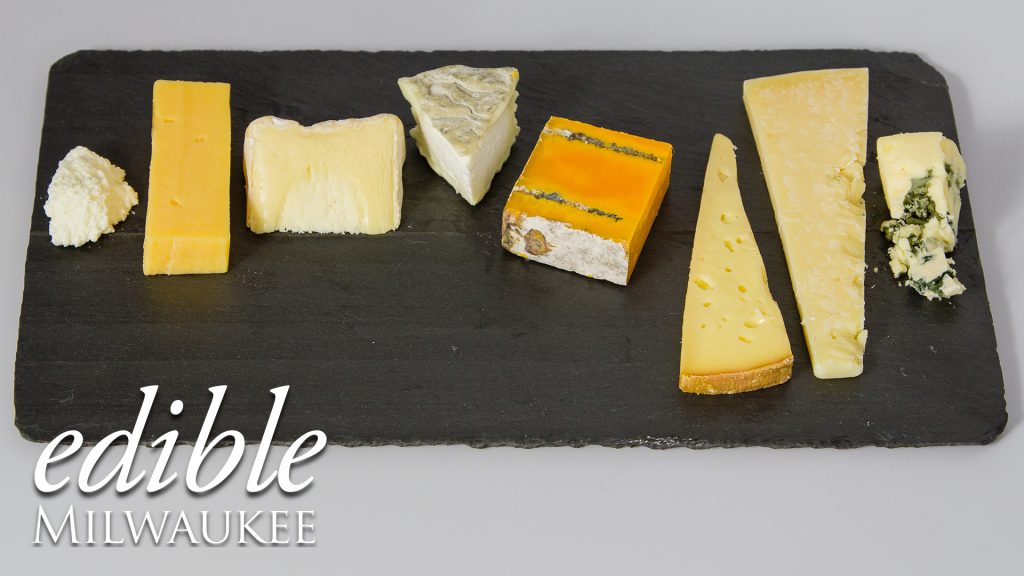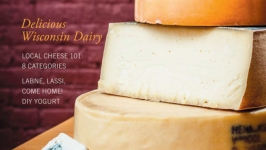Cheese 101: Cut Into 8 Categories
With hundreds of types, styles and varieties of cheese available to us lucky folks here in Wisconsin, deciding which to buy can be daunting. But once one knows the eight basic categories of cheese and the characteristics that make each unique, picking the perfect cheese becomes easier.
Fresh
Although it may seem simple, fresh cheese is one of the most diverse categories. Fresh simply refers to cheeses that are not aged. This category includes soft—think milky and fluffy—such as fresh goat cheese; cheese made from whey, such as ricotta; and pasta filata (Italian for “spun paste”), and cheeses like fresh mozzarella.
Because it has not been aged, fresh cheese retains the color of fresh milk. That means fresh goat cheese is always pure, snowy white, and sheep’s and cow’s milk cheeses might vary from bright white to slightly golden, depending on how much grass the animal is eating.
Jeanne’s pick: Driftless sheep’s milk cheese from Hidden Springs Creamery in Westby, available in flavors such as basil and olive oil, maple, cranberry and cinnamon, and others.
Semi-Soft
A semi-soft cheese, like colby or havarti, often features tiny holes because these cheeses are only lightly pressed. Semi-soft cheeses are springy to the touch, mildtasting and typically excellent for melting and cooking.
Unlike fresh cheese, which may take more than 24 hours to make, almost every other category of aged cheese follows a traditional cheesemaking formula. First, milk is heated and starter culture added. Then, rennet is added to coagulate the milk. The curd mass is cut and often stirred, and whey is allowed to drain. Curds are placed into forms, pressed and salted. Finally, the cheese is either placed in an aging room to develop a natural rind or sealed in plastic to age under cold temperatures.
Jeanne’s pick: Widmer’s Mild Brick, invented in Wisconsin and crafted by hand at Widmer’s Cheese Cellars in Theresa. In fact, Master Cheesemaker Joe Widmer still uses actual bricks to press and expel whey from the forms.
Soft-Ripened
Unlike other cheeses, soft-ripened cheeses get softer as they age, which is unusual because aging is a process of moisture loss. But with soft-ripened cheeses, mold on the rind breaks down the cheese and softens it over time.
This category is also called bloomy-rind because most feature white mold rinds that protect the cheese from unwanted mold growth during the ripening process—think brie and camembert. The white rind is usually courtesy of Penicillium candidum, which may be added to milk during cheesemaking or sprayed onto the rind at the start of aging.
Jeanne’s pick: Leopold, from Creme de la Coulee Artisan Cheese in Madison. Cheesemaker Bill Anderson modeled this beauty after Chaource, a relative of brie and camembert traditionally made in the Champagne region of France.
Surface-Ripened
Technically, soft-ripened and washed-rind cheeses are also surface-ripened, but the difference is surface-ripened cheeses have a wrinkly rind. These cheeses also taste different, have a firm and chalky texture, and are typically made from goat’s milk, such as Monte enebro from Spain.
The main attribute distinguishing these cheeses is the predominance of a yeast called Geotrichum candidum, which contributes to flavor and rind texture. It can be introduced to the milk during cheesemaking, exist in the air of the aging facility, or be sprayed on the cheese’s rind to promote rind development.
Jeanne’s pick: This style of cheese is not commonly made in Wisconsin, so seek out Vermont Butter & Cheese Company’s Bijou, Bonne Bouche or Coupole.
Semi-Hard
This big category includes cheddar, swiss, gruyere, gouda, romano and many creative variants. Texture derives from two distinct steps in the cheesemaking process. First, curds are heated; second, after curds are put into molds, the cheese is heavily pressed. Both steps extract moisture, resulting in a low-moisture, semi-hard cheese.
Jeanne’s pick: Red Rock from Roelli Cheese near Shullsburg. This cheddar with blue veining and natural white-mold rind is as beautiful as it is delicious.
Washed Rind
Two types of cheese make up this category. The first are the stinky, sticky cheeses such as limburger, taleggio and aged brick. They tend to be creamier because during the cheesemaking process, curds are cut larger and whey is drained without pressing the curds. Then, during the ripening process, the cheese is literally washed in anything from beer, wine, brandy, or saltwater. Almost all cheeses in this category are washed in a brine solution that contains Brevibacterium linens. B. linens prevents harmful molds from infiltrating the cheese while allowing good molds and bacteria to ripen the cheese, and it imparts a signature tan to bright-orange color. And yes, B. linens is responsible for the strong aromas that accompany this style.
The second type is quite different and includes firm, low-moisture cheeses such as Pleasant Ridge Reserve and gruyere, which are washed with a saltwater-bacteria solution during the aging process, encouraging the growth of certain bacteria and imparting specific flavors. Instead of getting oozier with time, this type gets drier with age.
Jeanne’s pick: Just across the border in Minneapolis, Cheesemaker Reuben Nilsson crafts Grazier’s edge at The Lone Grazer Creamery. Milk is sourced from two family farms, and cheese is washed in 11 Wells Rye Whiskey.
Hard
Usually hard cheeses, like parmesan and pecorino, have big, bold flavors and are fantastic on their own. They can also be grated and used in cooking.
Hard cheeses are typically made from milk skimmed of cream, reducing the amount of fat and setting it up for long-term aging. Curds are also heated at high temperatures to expel whey and extract moisture. The smaller and drier the curds, the drier the final cheese.
The main flavor components of hard cheese are both salty and sweet. Sweet derives from the breakdown of protein and fat, which releases compounds that produce fruity flavors and aromas, such as toasted pineapple. Salty comes from brining or handrubbing with salt, and from losing moisture as the cheese dries, concentrating the protein, fat and other solids. This also explains why hard cheeses are sometimes grainy.
Jeanne’s pick: SarVecchio from Sartori Cheese in Plymouth. This aged parmesan also features tyrosine crystals, resulting in Pop-Rocks-like flavor bursts.
Blue
Many countries boast a traditional blue, such as Roquefort from France, Stilton from England or Gorgonzola from Italy. Most are made from the Penicillium roqueforti mold strain, originally derived from moldy bread. To make blue cheese, cheesemakers add mold spores directly to milk during the cheesemaking process. Cheese wheels are then pierced to introduce air into the interior, and the air interacts with the P. roqueforti to create blue veins.
A characteristic common to almost all blues is saltiness. After that, blues can be divided into three types: creamy, creamy-crumbly, and firm.
Jeanne’s pick: Hook’s Blue Paradise, a super-creamy blue made at Hook’s Cheese in Mineral Point.






